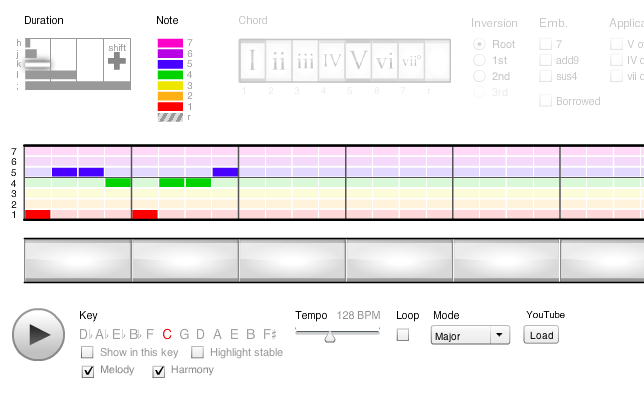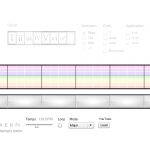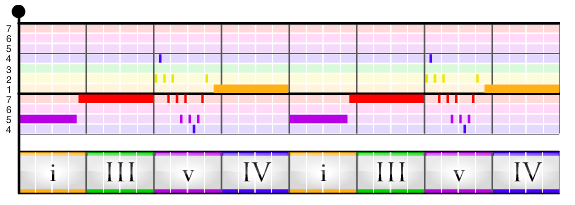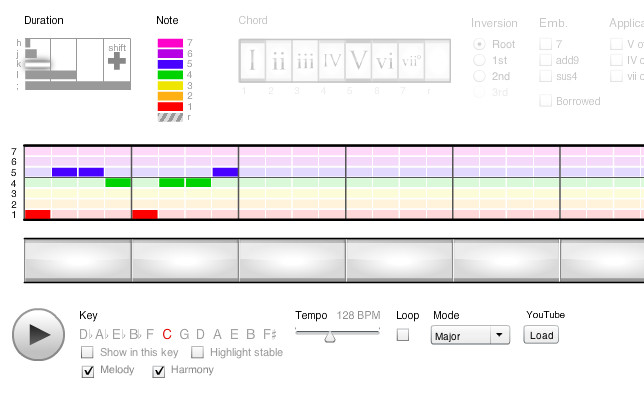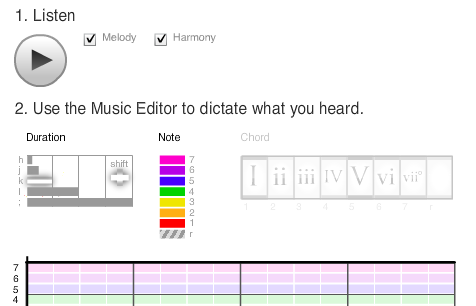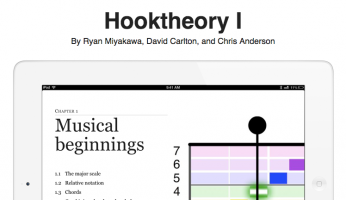 Hooktheory.com is an exciting new site which promises to make learning music theory more fun and engaging than ever before. It features chord analysis of current pop songs, innovative ways to explore chord progressions, and daily ear training challenges.
Hooktheory.com is an exciting new site which promises to make learning music theory more fun and engaging than ever before. It features chord analysis of current pop songs, innovative ways to explore chord progressions, and daily ear training challenges.
Today we’ll take a quick tour of Hooktheory.com’s features, and then get the low-down direct from David Carlton, one of the site’s founders.
Hooktheory is based around using “relative analysis” to simplify the understanding of melody and harmony in music. This means that instead of thinking in terms of “C, F and G” chords for example, you’d think about “I, IV, V“ – or, as Hooktheory would have you thinking: 1, 4, 5 (… or even red, green and blue! More on that later…)
Scales are treated the same way: instead of worrying about key signatures and the details of letter names for notes, everything is boiled down to the scale degrees 1 through 7.
This approach can be a great way to boil music theory down to what really matters.
Just like learning about 3 chord songs and the I-IV-V or using solfege for ear training, the relative-naming approach used by Hooktheory just might give you the insight into how music works that you’ve been looking for…
Let’s take a quick tour around the main areas of the Hooktheory site.
Song Analyses
A crowd-sourced database of the harmonic and melodic content of songs, covering rock, pop and more. Hooktheory uses innovative visualisations and a powerful interactive song player to let you explore the theory behind the song you’re hearing. It ties in directly with YouTube videos (so you hear the real song) or can synthesise simple piano arrangements (so you can hear more clearly what’s going on).
Here’s an example of a Song Analysis:
Blog
The Hooktheory team have been publishing some fantastic articles analysing modern music and explaining what’s going on. Lots to learn, and entertaining too, the blog posts are well worth a read!
Song Editor
The Song Editor is what powers the big database of analyses. You can use it to create a transcription of a song you know, and sync it up with the YouTube video. Or start from scratch to compose your own creation!
EarTrain
Naturally, this is our favourite part of the site: Daily ear training challenges at three levels (beginner, intermediate and advanced) required you to listen, and then use the song editor interface to re-create what you hear, in terms of melody and/or chords, depending on the challenge.
What’s most fun here is that the songs are taken from the main database, so you can as easily get “Call Me Maybe” as “Jingle Bells”!
See the ear training feature in action:
Let’s start off with the origin story:
Where does the team come from, geographically and musically – and what was the inspiration to create Hooktheory?

The Hooktheory team: David Carlton, Ryan Miyakawa and Chris Anderson
We each have very different music backgrounds, and I think this has been a real asset because it’s meant that we all come at things from different points of view.
I’m classically trained and grew up taking piano lessons and playing the trumpet, but before college I hadn’t taken a lot of serious harmony or ear training classes. Ryan started playing the piano when he was 3 and is certainly the most talented musician of the group. He has a really impressive ear and is a talented composer. Chris is the “casual/self taught” guitar player of the group. That’s been critical for us because I think things could have gone really differently if we were just a bunch of music theory nerds.
We’ve been best friends for years and Hooktheory was, at first, a great project for the 3 of us to work on as a hobby in our spare time.
I think things could have gone really differently if we were just a bunch of music theory nerds.
Hooktheory really began as course in the Music Department at UC Berkeley that we taught as part of the DeCal program there. As we were teaching the course, we were actually creating and laying the groundwork for a lot of the tools on our website now. It was all very primitive back then, but the response was so positive from the students that we decided to keep going after it was over. It’s all sort of snowballed from there.
The site has been public for less than a year, and we’re still relatively small, but we’ve been ecstatic with the rate at which it’s growing. I don’t have any specific usage numbers breaking down groups, but we did just recently pass our millionth visitor.
Most people who visit the site don’t contribute to the database. We think that’s fine. We recognize that it takes a really good ear to be able to analyze the chords and melody of a song just by listening to it. We’re starting to build a great community of really talented people though, and it’s really fun to see what songs get analyzed for the database each day.
Most of the people who come to the website are there to consume the analyses that have already been added, ask questions about the harmony, and use the other tools we’ve built. It’s been very gratifying to hear all the creative ways that people are using our Music Editor. We’ve had teachers from around the world send us emails saying how much of a difference it’s made in the classes. At the same time, we’ve heard from many singer-songwriter types telling us how the editor has helped with their songwriting.
Were there any big surprises that emerged as you analysed the database?
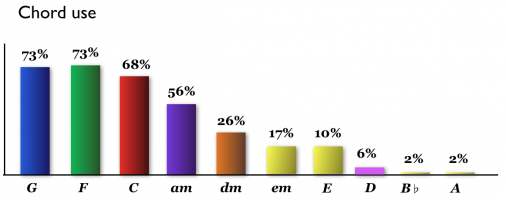 One of the things that surprised us was the pushback we received from people who were convinced that popular music all uses the same 4 chords and isn’t really worth analyzing.
One of the things that surprised us was the pushback we received from people who were convinced that popular music all uses the same 4 chords and isn’t really worth analyzing.
There certainly is a lot of simple music that is making it onto the Billboard charts, but there’s also a lot more complexity than some people give credit.
I think our latest Trends tool, if nothing else, does a lot to dispel this myth. It has definitely revealed patterns that we didn’t expect. It’s also really easy to get lost just clicking around finding new patterns used in songs. We had a great time creating it.
What’s the motivation here?
That’s a great question.
Ryan actually has a fascinating condition called Synesthesia in which different senses are crossed and perceived simultaneously. When he hears a certain note, he immediately senses a very specific color as well. Part of the reason his ear is so good (he can listen to a complicated jazz piece for the first time and immediately identify all the chords) is from the extra help that these color associations give.
Adding extra senses when you’re learning a new concept is almost always a great way to strengthen the connections for it in the brain. It’s easier to memorize something if you hear it, speak it, and read it, instead of just doing one of those things.
In this case, we’re adding an extra association with scale degrees and harmony but the idea is the same. I’m no synesthete, but I’ve definitely seen a lot of improvement in my own sense of pitch as a result of staring at these colors for so long.
Is there any drawback to students learning these associations if they aren’t used elsewhere?
We ended up going with the colors of the rainbow because it’s an ordering that most people are familiar with; it’s easy for people to make the connection between Red, Orange, Yellow = 1, 2, 3.
And before you ask, No, these colors are not the colors that Ryan sees! He had strong objections initially, but eventually we convinced him it was for the best. He has some odd color associations and the staff would have looked really strange. Plus it would have been really difficult to explain to people why we ended up using that specific shade of sea foam green for V chords…
We don’t think there’s a big drawback for people if they don’t see these associations elsewhere. In our minds, they’re a nice bonus for people to have and can only help. Obviously in a perfect world, everyone would be learning how music works using our system. One can always dream.
Have you seen any innovative or unexpected uses of the song editor by users?
From a middle school teacher in Vietnam, to a college professor in California, we’ve gotten great feedback for how the editor has dramatically improved their teaching.
As I mentioned earlier, apart from its obvious use as a classroom tool for teaching harmony, we’ve seen a lot of people use it for songwriting. Exactly how they use it for songwriting varies greatly, and it’s been fun to get feedback in the form of feature requests etc. that hint at the different ways people have integrated the Editor into their workflow. The MIDI export was a feature that we added “just because we could”, but it’s meant that people can write a chord progression with the Editor and then import the result into any tool they desire.
We’re always touched by the teachers who have written us to say how much a difference the Editor has made in their classes. From a middle school teacher in Vietnam, to a college professor in California, we’ve gotten great feedback for how the editor has dramatically improved their teaching.
One teacher had been using the tool all year in their harmony class. As a final project, all the students wrote a song in the editor and were able to export a professionally engraved score in addition to a recording generated by our software. These were very young kids without a lot of prior background who ended up being able to effectively use the rules of harmony to write a song from start to finish.
This is the kind of thing that drives us and makes us do what we do.
Have you been able to watch users improve as they use this day by day?
We do keep track of that data and we are working to do something with it to help people track their improvement. We haven’t done anything with it yet, but it’s in the works. It might also be neat to aggregate it and show how fast the “average” person’s ear improves as a function of the number of exercises they have completed.
Can the Hooktheory approach or philosophy be carried into other areas of music education?
Possibly. There’s a lot more to music than chords and melody.
Of course, as a medium for artistic expression, you can only get so far by deconstructing everything to basic principles. There are always going to be many intangible components to music that don’t lend themselves very well to strict analysis.
On the other hand, though we’re currently very focused on the music theory side of music education, I do think we could make an impact on the instrumental side of things as well (i.e. learning the guitar or piano).
The book is based on a lot of the material that we wrote for the aforementioned Berkeley class we taught. It’s filled with many song examples using our notation system and is meant as an introduction to relative notation, scale degrees, and harmony.
When many people think of “Music Theory”, they think of scales and key signatures, conventional music notation, and other technical concepts. These things are also really important, but I do want to emphasize that this book purposefully doesn’t spend a lot of time in those areas.
In some ways, what we’re doing is more advanced and yet simultaneously more basic and fundamental.
In classrooms, we are seeing teachers use it as more of a companion to formal texts for getting students excited about music theory by showing them what a little knowledge can do (which is sometimes the hardest part!). At the same time, we’ve tried to make it as standalone as possible for the casual musician who wants to know more of the “why” as opposed to the “how”.
We’re working on a lot of projects internally, and we have some great ideas for how to continue surprising people with ways we can use the data in the song database to “shine a light” on how music works.
We’re also going to make a big push towards making these tools more useful to teachers and professors in their classes.
We see a big role for Hooktheory in the classroom going forward.
We can’t wait to see how Hooktheory develops!
Have you tried the Hooktheory method? Let us know what you thought in the comments below!

